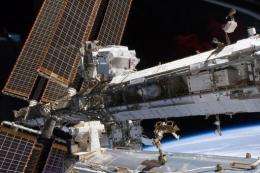This NASA image obtained in May 2011 shows the International Space Station's starboard truss. NASA is mulling the worst-case scenarios of leaving the $100 billion International Space Station unstaffed for a period of time following the crash of a Russian rocket, US astronauts said Tuesday.
NASA is mulling the worst-case scenarios of leaving the $100 billion International Space Station unstaffed for a period of time following the crash of a Russian rocket, US astronauts said Tuesday.
Two Americans aboard the ISS, Ron Garan and Mike Fossum, told reporters in a video press conference from space that they have begun minimal preparations, namely taking video of some tasks in order to quickly train future station staff.
However, NASA mission managers in Houston are hard at work on contingency plans after both Russia and the United States admitted that abandoning the research outpost, at least temporarily, is a possibility.
"You have to start working right now to say 'what if?'" said Fossum. "There are a lot of efforts going on to look at all of the different options that could possibly come into play."
Six people -- three Russians, two Americans and one Japanese astronaut -- typically staff the research station on six month rotations.
But last month's failure of a Russian Soyuz rocket to lift its unmanned Progress cargo vehicle into orbit has raised questions about the ability of Russia to tote people to the ISS.
The same rocket technology is used for crew capsules. An investigation into why the rocket failed is now in its second week.
Russia's space agency is now conducting a check of all its rockets after the disaster, which followed three other failed launches of satellites since December in an unprecedented catalogue of accidents.
When the US space shuttle program ended earlier this year, Russia became the sole nation capable of carrying humans to space.
"It is possible that we will have a station without people on it for hopefully a short period of time," said Fossum.
"We haven't started anything specific up here pertaining to that except for maybe documenting some of the things that we do on video so we that can use video products for part of the training for the next crew," he added.
"The teams in Houston are in the preliminary stages of deciding everything from what ventilation we are going to leave running, what lights we are going to leave on... every tank, every valve, every hatch."
Some of the more dire possibilities include a leak that could depressurize a big section of the lab, or an ammonia pump breakdown which would disrupt cooling to the station.
A failure in the cooling system last year required three complex spacewalks to swap in a new pump.
"The space station does require some care and feeding so it is important for us to be here if we possibly can," said Fossum.
Another possibility is that the crews will have to do a quick handoff from one skeleton staff to another, or no handoff at all. Three crew members are set to depart later this month, while Fossum and two others will remain until November.
"A short gap is not a big deal but... as that short gap turns into many months then your probability starts to stack up against you and it leads to a greater possibility that we would have a problem up here that (would become) very significant with nobody to take action," said Fossum.
The ISS, which orbits 350 kilometers (220 miles) above Earth, is a sophisticated platform for scientific experiments bringing together space agencies from Russia, the United States, Europe, Japan, and Canada.
Launched in 1998, the ISS was initially expected to remain in space for 15 years until an agreement was reached to keep it operating through 2020.
It has been continually staffed for more than 10 years running, which Fossum described as "a source of pride."
Garan added that the host of science experiments on board the space station, which is expected to keep running until 2020, will continue whether humans are there or not.
"In the unlikely event that we do have to unman the station there will still be science conducted on board, it just won't be crew-based science," he said.
(c) 2011 AFP




















